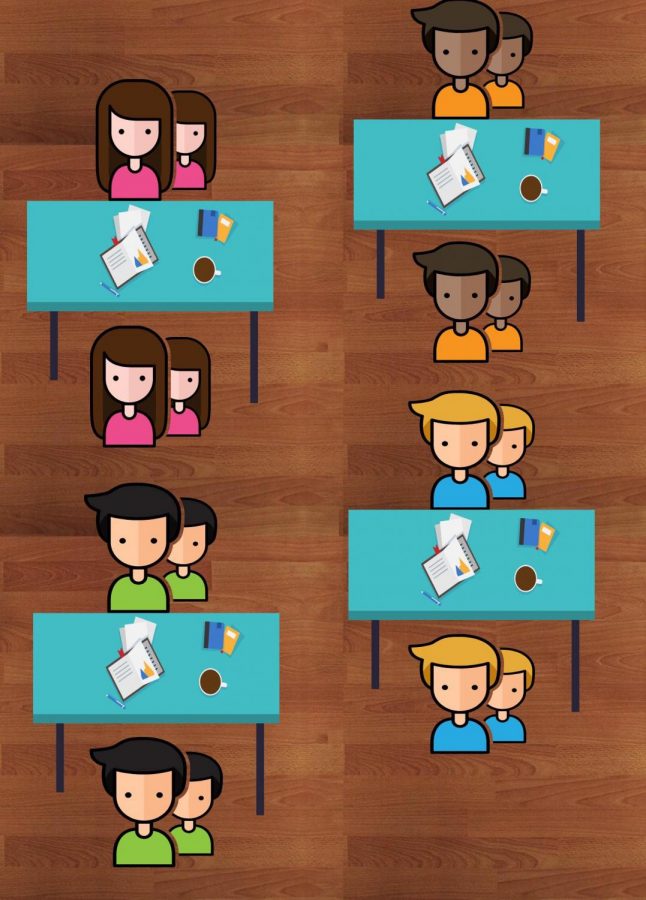Where does the gender gap STEM from?
A gender disparity is still apparent in high-level STEM courses.
August 30, 2018
Loud voices emanate from an AP Physics C classroom as students frantically prepare for their upcoming exam. Senior Anisha Sinha struggles alongside her group mates as they attempt to figure out a particularly challenging problem. As they discuss, Sinha notices something. They’re all girls. She looks to her right. The group there consists of all boys. She briefly wonders why that’s the case, before returning to her physics problem.
AP Physics C is only one of the many high-level STEM courses in MVHS that tend to have a gender disparity, usually consisting of more boys than girls. For instance, in Jim Birdsong’s AP Physics C classes this year, the ratios of boys to girls are 27:8, 25:7, and 29:7 in respective periods.
Sinha attests that most students don’t even notice it, because she believes Monta Vista is generally very accepting of girls in STEM. At the beginning of the year, however, this disparity was apparent, since most girls worked with girls and most boys worked with boys. As the year progressed, this divide ceased to exist.
“It’s not something that I noticed at first,” Sinha said. “But when someone brought it up I was really shocked. Living in the Silicon Valley, you would expect the gender disparity to be less than other places. But it still exists, and I think it’s important to [realize this].”
The gap in Sinha’s AP Physics C class last year didn’t affect her performance in any way, shape or form. In fact, she felt relatively indifferent about it.
Junior Matthew Cho, who is concurrently taking AP Physics C and AP Calculus BC this year, feels the same way.
“Especially in this area, we’re much more liberal,” Cho said. “More people are expected to [take STEM classes], and the expectations aren’t selective. Therefore you’ll end up with a more equal [range of genders in classrooms].”
According to AP Physics teacher Sushma Bana, this disparity may be perpetuated by traditional gender roles that have been reinforced in the MVHS community, a community where the majority of people are immigrants. Immigrants that generally grew up in places where typically, women weren’t common in STEM.
Sinha contends to this as well. She points out that even though girls are encouraged in many ways to partake in STEM, such as the introduction of clubs like GWC (Girls Who Code) in the Bay Area, the disparity is still apparent. She admits it may come from the fact that women haven’t been as accepted in STEM fields throughout history, and the traditional beliefs and roles that’ve been reinforced don’t go away easily.
“It’s that older thought that still subconsciously affects people’s decisions,” Sinha said.
Bana believes that altering these stereotypes that are so deeply embedded within society is difficult. She believes that in a lot of cases, even parents don’t encourage or support girls taking high-level STEM courses as much as they should.
“This is just that [thought of] ‘oh girls do biology more and those are the fields that appeal to the girls more,’’,’” Bana said. “[Whereas] physics, and chemistry to some extent, but physics more so [is considered] to be a boy’s field. It’s just a traditional way of thinking.”
According to Birdsong, the classroom environment is somewhat negatively affected as a consequence of this gender gap. Especially when it comes to group work, Birdsong has observed that male students tend to get ideas and run with them, often not communicating as well as their female counterparts. Because of this, Birdsong notices that there isn’t as much cooperation in his classroom as he would like.
“Maybe it’s like an extension of [conducted] studies that show teenagers, males in general, of being impulsive,” Birdsong said. “Doing things immediately. Females tend to be more thoughtful. [Due to this], teachers are taught to not call on the first hand that goes up, but rather to wait.”
Birdsong believes that boys and girls have different natural tendencies, which may also play a role in gender disparities. He believes that girls— for whatever reason— have generally been taught or expected to consider a lot of things. They like to test all the waters when it comes to different academic fields before commiting.
“You have to speak really generally with stuff like this, but guys have decided what they want to do,” Birdsong said. “They know they need to specialize in something, they know they’re going to be engineers or something, so they know they need physics and aren’t afraid to concentrate on it. Whereas females may be more [inclined to] wait and see.”
Bana agrees with Birdsong, and observes that boys tend to dominate and girls tend to be quieter while participating in class discussions or simply answering questions. Although she does believe that confidence among girls is improving, she notices that they generally need more reassurance that they’ll be able to succeed in a difficult STEM class.
“Before I became a teacher, I worked in the [STEM] industry for about ten years,” Bana said. “I feel that with girls, there is this pressure to prove yourself. It’s almost as if we have to justify that we belong here.”
Despite the gender imbalance, Cho attests that it doesn’t result in direct discrimination, and for the most part, females in STEM classes are treated no differently than males.
“We’re beyond that ––- at MVHS at least ––- and it’s to the point where it’s like you’re just another classmate,” Cho said. “[We don’t] treat [each other] higher or lower. You’re just another person I’ll do physics with. We’ve gotten to that point, at least here.”
As for the disparity itself, Birdsong agrees that the community is making progress to bridge the gap between males and females in higher level STEM classes.
Over the last 10 years, the Monta Vista Physics Department has grown from a single male teacher, Birdsong, to 4 teachers— two of whom are female. Bana comments that when females view a female teacher teaching, they tend to have a change in perception. They become more inclined to take the class, believing that they too can do it.
“This has been an issue forever,” Birdsong said. “It’s getting better, but every four to five years this article gets written. And it’s good because things over a period of time do change and I think it’s getting better. Right now, there is a disparity, but I do think it’s smaller now than it was before.”



















